
|
Note ye ed's email address: stevebryant99@gmail.com. |

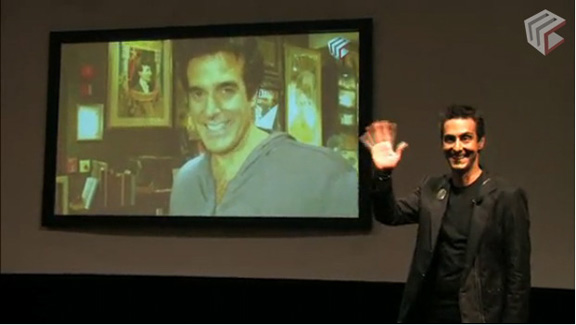
The best of two countries.
|
July 2011 Summertime, and it's sizzling in Indiana. No one wants to venture outdoors. Fortunately, I didn't need to in order to attend a three-day magic convention, take two of Luis de Matos' Essential Magic Conference. A full report follows, along with consideration of a new book of seance tips, a vintage Trick Talk, and a new version of Triumph by Dani DaOrtiz. I think the Professor would have loved it. I hope to see you all next month in Las Vegas! |
|
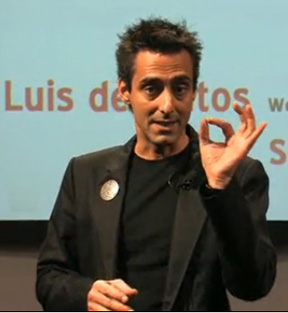 Luis as the perfect host. |
OBRIGADO, EMC 2011 -- OK, it is majorly cool that you can sit in your bedroom or office and attend one of the best magic conventions ever, thanks to Year Two of the Essential Magic Conference. Once again, Luis de Matos, Marco Tempest, and David Britland assembled thirty A-list friends along with a video link to David Copperfield in Las Vegas and pumped out sixteen hours of amazing content over a three-day period, July 7-9. |
|
Moreso than last year, there were a few technical glitches, so let's get them out of the way. The beginnings of the first seven of nine sessions were plagued by dropouts in the feed, presumably from everyone hitting the server at once. Although this was annoying, Marco Tempest and his crew generally resolved the problem by five minutes into each session. On the plus side, the sessions were posted for download much faster than last year. Session One, for example, was online before Session Two began, and so on. Thus, anything you might have missed because of a lost feed was quickly available. I never experienced any trouble checking out these sessions after the fact. But on to the magic! Let me focus on three performances that put this year's convention into the "epic" category: | |
|
1. Lu Chen presented his version of the Berglas Effect. Isolated from the cards, he had two roses tossed into the audience. One recipient named a card (7 of clubs), another a number (31). David Britland dealt from the top, and you know the rest. A stunning effect, wonderful staging. If you have access, watch it again just to enjoy his bow. 2. Rene Lavand performed his incomparable Oil and Water. When the colors and suits of the entire deck separated, following a full deck riffle shuffle, he received a standing ovation. In a later session, he explained some of his "compositions," effortlessly dealing seconds and thirds with one hand. | 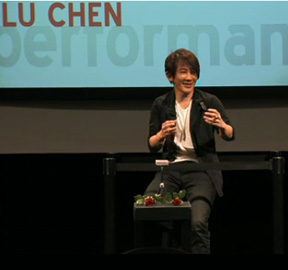 How to do the Berglas Effect for a billion viewers. |
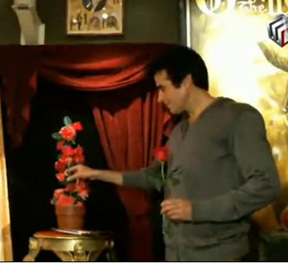 David performs the blooming rose bush. |
3. David Copperfield conducted a tour of his museum and responded to questions from the audience. One rarely sees David "up close"; he is usually locked into his TV or stage patter, or giving sound bites in interviews. Here, he was warm, open, accessible, and had obviously put a lot of thought into organizing his tour. This was one the most enjoyable segments of the convention. |
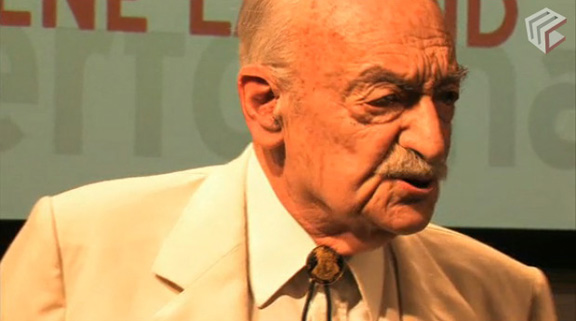 Rene Lavand. And so much more, in no particular order ... Eric Mead, celebrating his birthday, recounted his life in magic, including a brilliant card trick he devised at age 13. It was disappointing that Eric didn't have multiple appearances, as he did last year, but at least he was a frequent contributor to the online chat and was an emcee. Rudy Coby lectured on how to be a world famous magician. I've heard this lecture before, and it's inspiring. Rudy didn't win the Desert challenge in Las Vegas, but he had $80K in bookings the next day. Nice consolation prize. Rudy always lights up a room. 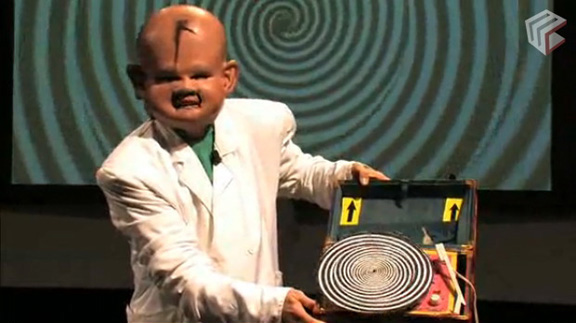 Hmm. Rudy hasn't aged very well. The Buck twins, taking turns, talked about the evolution of flourishes and effects, easily commanding the attention of those assembled. Their serious approach and mode of speech remind me of that of Steranko. Jonathan Bayme discussed his jam packed history in magic (he's only 24), leading to the creation of Theory 11. He once raised $83K for his high school. Fascinating. Apollo Robbins gave a most interesting talk on managing the attention of an audience. Later he and his charming new bride would do two-person mentalism. They did it swell, but I would have first considered Brian Gillis and Sisuepahn or the Evasons for such an act. Max Maven performed a terrific card trick for the Buck twins, calling them "Duane" and "Donald" because he "knows them," a trick that uses the cards and a smart phone to answer questions about life, the universe, and everything else. Max would later supply the method. In another session, Max tipped his work on the Hindu Shuffle. (This was merely an example, a fine one, in a talk on straight-line methods.) 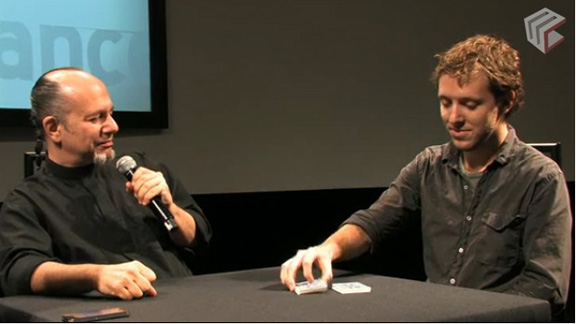 Max shows the Buck twins a card trick. Stan Allen returned with more things to think about, supplementing his list of 33 from last year (when he got to only 22) to get the number up to 44. I didn't count, but this year as last Stan's talk proved to be one of the most popular presentations. I love lists. Hey, I think we're in one. Dani DaOrtiz was my favorite "new" face last year and it was a joy having him return. Dani has such a fun, easy-going personality that he can get away with murder. He performed several effects over two sessions, including one stunner that he will eventually teach in a DVD called Utopia. Dani had four spectators mix their cards in a chaotic manner, it being impossible to follow his machine gun instructions, and yet each finally found his own signed card at position five in his packet. Dani claims this is a self-working effect. 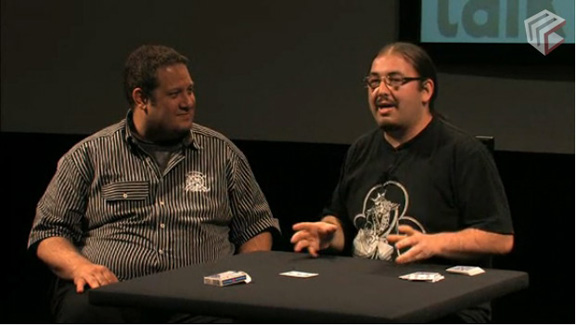 Dani entertains Christian Engblom. That's Christian Engblom up there with Dani. Christian did a Cards to Pocket after which both his pockets disappeared. Luis de Matos performed an Egg Bag routine with the bag apparently being his trousers pocket, but more importantly discussed how he used to make a spectator's car vanish off the street and appear in the theater lobby. He did this over 100 times, and the method was like something out of Mission Impossible. David Britland, in a talk on the first psychological illusionist, ran a film clip of Chan Canasta performing a book test. Canasta took amazing chances based on audience psychology. | |
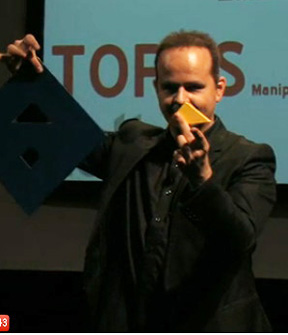 Topas goes geometric. |
Topas did an eye-popping trick in which colored geometric blocks are placed into geometric holes in a flat panel, but which change from triangles to squares etc. in the process. This completely mystified me. Later he did a funny blade through arm three ways, as done in rehearsal, on opening night, and after a thousand shows. Akira Fujii taught his incredible muscle pass and classic pass. Both are well beyond my talents, but fun to know about. |
|
Bill Kalush, using Houdini as the example, spoke on how to become immortal. This was one of the top talks of the conference and held everyone's attention. As he did last year, Bill generously gave attendees a month's pass to his Conjuring Arts database. Richard Wiseman fooled everyone with an optical illusion involving a sponge ball in a wine glass and very nicely explained it later in a Q&A session. Richard is always fascinating. David Kaye understands his audience perhaps better than any magician alive. After discussing three principles on how to entertain kids, he walked the walk with a video demonstration. I've seen him do this before, and the audience reaction he gets is outstanding. Marco Tempest is a technical wizard and proved it via an app that seemed to run on three iPods simultaneously. Most magical. Mike Caveney lectured on and demonstrated the Million Dollar Mystery. Mike has become magic's most entertaining historian. Lennart Green performed what may belong with my three "epic" mentions above, but it depends on a method that he will release later via DVD. Lennart completed a magic square (the top row of numbers was forced on him), to the usual effect of the numbers adding up the same, every which way. The new aspect is the method, which he claims is easy, involving no templates or calculation. I look forward to this. Gaeton Bloom did an act that would have fit Rudy Coby's three perfect minutes toward becoming world famous, an act that more or less begins as a cut and restored mic cord, then gets crazy from there. Paul Daniels had the unenviable position of not only following David Copperfield but of closing the conference. He succeeded quite well at the task by teaching his Chop Cup routine, especially how to do it for television. 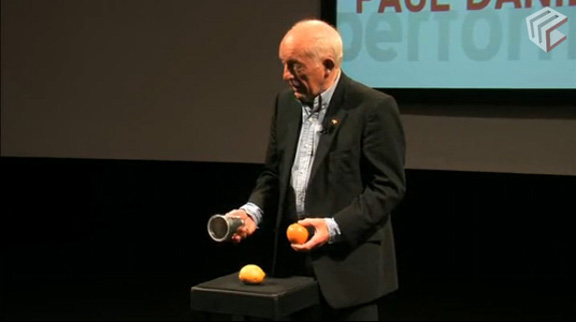 If you liked the orange, you'll love the lemon. I know, I know, there were others, such as the legendary David Berglas (whose bits I missed), but technical flaws and/or family interruptions kept me from viewing everything. I am not attempting to give a complete review here, but merely a sampling to remind myself of what was available, and to hopefully entice you to enroll, which you can still do for only $90. Eventually, as last year, we are to receive DVDs of the entire affair. Most of the material was absolutely first-rate, and I frequently found myself physically applauding along with the studio staff/audience. The online chat was fast and furious and occasionally as much fun to monitor as the live video. The cast made it even more fun by joining in on this. As last year, big thanks to Luis, Marco, and David for hosting one of the best conventions of the year. | |
|
|
BOO! -- Valued readers, especially purchasers of The Little Egypt Book of Ghosts, know that we are highly fond of dimming the lights and frightening patrons with things that go bump in the night. If you share that personality defect, you are encouraged to acquire a copy of Entity's 20 Tips for Seance Workers, by Tom Baxter. The book began its life as an e-book in 2010 and is now enjoying an afterlife as a softcover physical presence, available from dealers everywhere. The twenty tips are spread over three chapters, "Tools," "The Seance Room," and "Mediumistic Manifestations." I found several items I'd love to try, and I expect you will too. Softcover, 52 pages, $25. 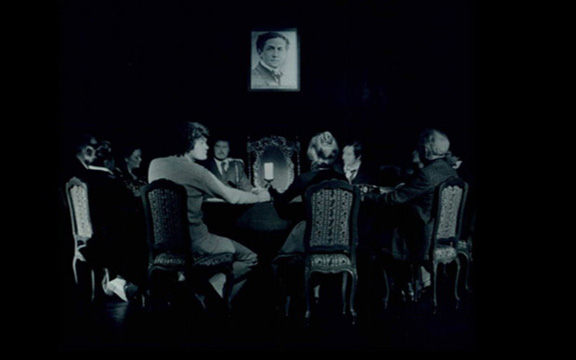 Dinner is always more fun with a ghost or two. Speaking of the talented Mr. Baxter, he is once again manufacturing a small batch of the Upton/Smith Rising Cards, available as far as I know only via the Genii forum. Check its banner ad for details. Highly recommended, reviewed here in May 2010. BACK IN THE DAY -- Most of us, at some point in our histories, have performed some famous magician's trick word for word. Imitation is an early part of our educations. Eddie Murphy learned to be funny by imitating Richard Pryor on TV. Alas, magician Jim Sommers took this practice a bit too far back in the day by building and presenting a copy of Robert Harbin's Zig Zag Illusion. Mike Caveney presented a talk on Jim's "scandal" at the 2010 Magic Collectors Weekend, and the talk appeared in print in the May 2011 issue of Magicol. | |
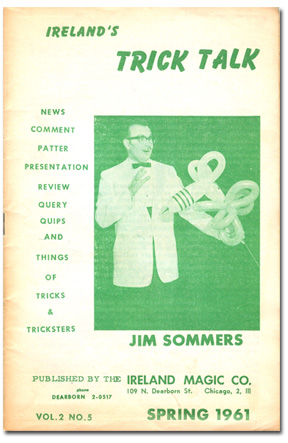 Trick Talk, Spring 1961 |
Prior to all this, Jim Sommers was a popular figure in the Jay Marshall community of magicians, hence his appearance on the Spring 1961 issue of Ireland's Trick Talk. The profile touts Jim as the inventor/builder of Ken Allen's Robot Coins in Glass, and his book of balloon creations, Blow by Blow, is advertised within for $2.00. The issue's news featured a list of magicians scheduled to appear on Don Alan's new show, "Magic Ranch," and recent showings of Richiardi, Jr., on Ed Sullivan and Marian Chavez on "Truth or Consequences." Frances Marshall was gearing up to celebrate her 30th year in magic on October 8. This issue of Trick Talk is one of the pair I purchased in May from Hank Moorehouse, and, given Hank's untimely passing, there is now another layer of nostalgia in my owning it. Some years ago, Joe Stevens offered me the option to do a cover story on Dale Hindman or on Hank Moorehouse, and I wound up doing Dale. Although Dale proved most interesting, I always regretted the missed opportunity to get to know Hank a little better. My fondest condolences to all those who knew him better than I. |
|
Here's an ad from the 1961 Ireland's Trick Talk, the trick Bill Malone built a career around. Talk about a buck well spent. 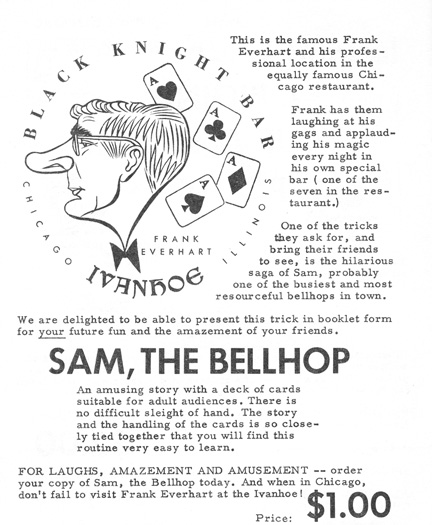 Have you ever been to the 654 club? | |
|
|
TRIUMPH IN SPANISH -- Jon Racherbaumer's Arch Triumphs, a collection of 13 versions of Triumph written in 1978, was written way too soon. Variations of this classic Stars of Magic effect continue to appear, many of them quite wonderful. The most recent to pique my interest is Dani DaOrtiz's Open Triumph, in which the cards are clearly displayed face up/face down in a spread deck right before the cards are spread to show a single reversed card in an otherwise ordered deck. Ordinary cards, ordinary skill. 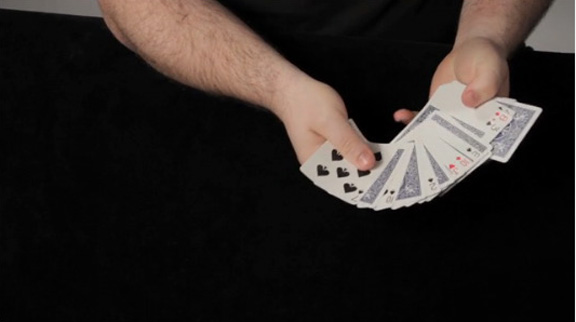 The cards are face up, face down. This is available as an online video from Dan and Dave Buck. My only reservation is that the hype for the effect suggests that many variations of the effect are superior to Vernon's original. Anyone who ever saw Ron Wilson perform it wouldn't say that. This said, I certainly have enjoyed numerous variations, and Dani's is one of the best. $11.95. 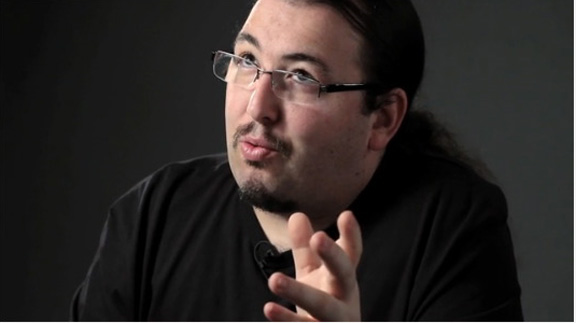 I dedicate this to the Professor. |
|
Read something fun at the beach.
Little Egypt Magic is the erratically updated web site of Steve Bryant, spawned (the site, not Steve) by a former internet magazine known as The Little Egypt Gazette/for magicians only. Steve Bryant is an obscure magician and writer who generates this site from an iMac in Bloomington, Indiana. He frequently journeys to and performs magic in Little Egypt, the local name for extreme southern Illinois, where the towns bear such names as Cairo, Thebes, and Karnak. Past issues of this web site: Index to Past Issues Notice: Any limited use of copyrighted images or quoted text is considered fair use, usually to review whatever product or event that is under discussion. If you object to use of any material, please get in touch and it will be cheerfully removed. |
A JSB Creations product
Copyright© 2011 by Steve Bryant